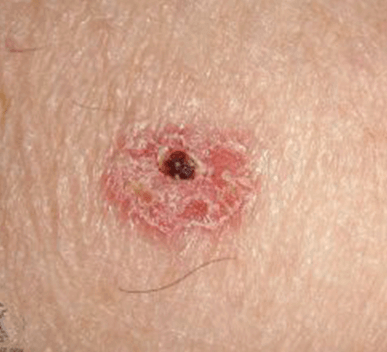Squamous cell carcinoma (SCC) is one of the most common forms of skin cancer with over 700,000 new cases diagnosed in the United States each year. It typically presents as scaly, red and grayish white lesions on the skin surface. It usually forms on areas of the body exposed frequently to ultraviolet rays from the sun or tanning beds. Although SCCs are usually not life-threatening, the cancer can spread to other parts of the body and cause health complications if left untreated.
Tues: 8:30am - 3:00pm
Wed: 12:00pm - 6:00pm
Thurs: 8:30am - 3:00pm
Fri: Closed
Sat: 8:30am - 12:30pm
Sun: Closed
Greenvale, NY 11548
Squamous Cell Carcinoma


What is squamous cell carcinoma?
What causes squamous cell carcinoma?
Squamous cell carcinoma is caused by ultraviolet radiation that alters the DNA in skin cells, causing new cells to form into abnormal cancerous cells. Regular exposure to natural sunlight or the artificial ultraviolet light emitted by tanning beds can cause the cancerous cells to develop, especially in individuals who have fair skin. Cancer-causing chemicals (such as arsenic), exposure to human papilloma virus, immunosuppressive medications, burns, and certain genetic conditions can also increase the risk of SCC development.
How dermatologists diagnose squamous cell carcinoma
Your dermatologist will examine the affected areas of your skin and ask questions about your medical and family history as well as your symptoms and when they first began. During the exam, your dermatologist will check the size, shape, color, and texture of the affected areas. Your dermatologist may use a dermoscopy instrument for close inspection of your skin. This device uses a magnifying lens and light source to view the area more clearly. Dermoscopy aids in making an accurate diagnosis.
A biopsy will likely be necessary to confirm the diagnosis. A biopsy is an in-office procedure where your dermatologist will numb the skin around the affected area and remove a small skin sample for further microscopic evaluation.
How dermatologists treat squamous cell carcinoma
Your dermatologist will plan a course of treatment based on the stage of the squamous cell carcinoma as well as your personal medical history.
While normally used for precancerous lesions, cryotherapy (freezing the cancer cells with liquid nitrogen) is an option for treating some thin SCCs.
Topical chemotherapy involves the application of anti-cancer medications applied directly on the affected skin and is another option in some circumstances for early SCCs.
Early or superficial SCCs can often be treated with curettage and electrodesiccation. Commonly referred to as “ED&C,” this procedure involves scraping away the cancer with a sharp instrument called a curette, then treating the area with heat from an electrode instrument to destroy any remaining cancer cells.
A surgical procedure called an excision is a common treatment for more advanced squamous cell skin cancers. This is an in-office procedure done with local anesthesia in which the diseased tissue is cut out and the surrounding skin is stitched together.
Mohs surgery may be recommended depending on the particular features of the SCC, such as the size and location of the lesion. Mohs surgery is a specialized procedure designed to remove as minimal of the normal surrounding skin as possible while providing the highest cure rate for the carcinoma.
Large tumors that cannot be safely removed with surgery may be treated with radiation therapy. This is a painless procedure similar to getting an x-ray, only the radiation is stronger and focused directly on the cancerous area. Radiation therapy side effects may include hair loss, skin irritation or changes in skin tone.
Rarely, systemic chemotherapy and oral medications may be used to treat lesions that are not amenable to excision or radiation therapy.
Squamous cell carcinomas are curable if caught early. If you have a lesion that is concerning for squamous cell carcinoma, you are encouraged to schedule an appointment with your dermatologist for evaluation.
If you are concerned about squamous cell carcinoma, click here to schedule an appointment with our board-certified dermatologists or walk into Walk-in Dermatology at your convenience for immediate evaluation.






